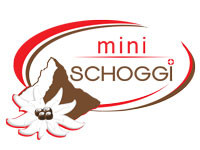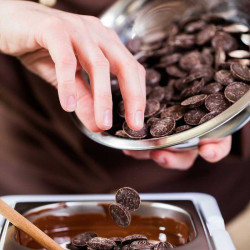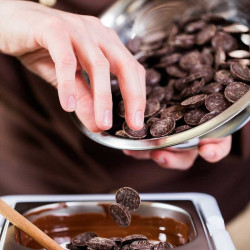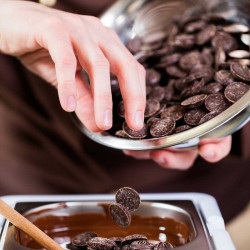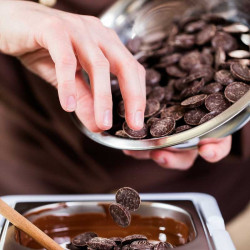Couverture tempering course
Testimonials
Kuvertüre Temperierkurs – Viel Abwechslung
Der Kurs war spannend und an Abwechslung fehlte es nicht. Die Tipps waren sehr hilfreich und 1zu1 umsetzbar.Kuvertüre Temperierkurs 4h – Einfach toll
Der Kurs war sehr gut aufgebaut und man konnte sich Zeit lassen. Es war nie hektisch und alle Fragen wurden bestens beantwortet. Die Schokoladen sind sehr fein!Kuvertüre Temperierkurs – Gute Kursstruktur
Sehr lehrreich, mit der Richtigen Menge an Hintergrundwissen für Laien. Kursaufbau sehr gut und keine Wartezeiten aufgrund der guten Kursstruktur und dem Zeitmanagement. Das Fachwissen in der richtigen Flughöhe an Laien vermittelt. So ist der Teilnehmer nicht unter- oder überfordert. Man hat richtig gemerkt dass die Kursleiterin für die Schokolade lebt. Einfach nur toll.Kuvertüre Temperierkurs – Konnte alle meine Fragen stellen
War super! Konnte alle meine Fragen stellen und weiss jetzt endlich, was ich vorher alles falsch gemacht habe :-)Kuvertüre Temperierkurs – Inhaltlich perfekt
Kann nur sagen, für mich war der Kurs inhaltlich perfekt. Lehrreich und einfach super. Werde sicher nochmals einen Ihrer Kurse besuchen.Kuvertüre Temperierkurs – Nun weiss ich, wie es richtig geht
Ich hätte nicht gedacht, dass der Kurs so lehrreich sein wird. Nach gefühlt hunderten Stunden verzweifeltem Temperieren zu Hause weiss ich nun, wie es richtig geht. So etwas lernt man in so kurzer Zeit nicht alleine zu Hause. Ausserdem war eine lustige Runde. Merci vielmol! Sehr professionelles Erklären. Jeder „Erfahrungsstand“ wird abgeholt. Wirklich toller Kurs!Kuvertüre Temperierkurs – Empfehle ich weiter
Ich fand den Kurs sehr gut und alle meine Unsicherheiten über das Temperieren wurden geklärt. Ich empfehle den Kurs jedenfalls weiter!Kuvertüre Temperierkurs – Auch für Laien gut erklärt
Ein wirklich guter Kurs, kompetent und auch für einen Laien gut erklärt. Sehr freundliche Kursleitung.Kuvertüre Temperierkurs – Interesse an Couverture
Spannend und lehrreich. Wenn ich das sagen darf einfach alltagstauglich, weil der Kurs aus meiner Sicht für alle ist, die Interesse an Couverture haben und für jeden verständlich ist.Chocolate courses
Nowadays, chocolate is an everyday product, everyone knows the sight of the noble treat. But as with many foods, there is more work and more knowledge behind the processing than one might think. Hardly anyone knows how to turn a bitter, inedible bean into an aromatic, melt-in-the-mouth couverture, and the right tempering process to give the chocolate a beautiful gloss and the necessary stability is also a bit of a science. At our courses you will learn what is really behind the delicate and noble chocolate.
Welcome to miniSchoggi
Learn everything about chocolate and its processing from professional confectioners and trained food technologists - with us it is possible. With scientifically based knowledge and a lot of experience, our course instructors introduce you to the world of chocolate. At our couverture tempering course, you will learn how to optimally prepare the couverture for molding into pralines, chocolate bars, decorations or hollow figures. Using various methods, you will ensure creations with a noble shine, a pleasant break and an excellent taste.
If you want to experiment with the cocoa bean rather than the finished couverture, the Bean to Bar course is for you. Under the expert guidance of our professional food technologist, you will put together your own desired couverture. Whether a fruity milk chocolate or a slightly sour dark couverture is desired, we will create your very own Bean to Bar creation.
Couverture tempering course
To make fine chocolates and hollow figures or to mold delicious chocolate bars, the couverture used must be tempered correctly. If this is neglected, the chocolate often sticks to the mold, possibly forming lumps and the finished products have a gray haze instead of a beautiful shine. To prevent this from happening, a professional confectioner will show you how to easily temper all types of couvertures at this course. You will learn the inoculation and the tabling method and temper white, dark and milk couverture right at the course. So you are perfectly prepared for sweet creations at home. In the course program, which you will receive at the course, you will find detailed instructions and tips and tricks - so nothing can go wrong.
Bean to Bar Course
Cocoa beans, once freed from the shell, fermented and separated from the pulp, must be sorted, dried, roasted and crushed. Only then have they developed a delicious cocoa aroma and can be combined with other ingredients. With these, they are finely ground and mixed in the so-called melangeur. Conching, the rolling with heavy stone rollers, makes the chocolate wonderfully melt-in-the-mouth, and after tempering it can be poured into various molds. What is normally done in large factories, you can experience for yourself with us. How your chocolate turns out is up to you. You choose your favorite from a large selection of different already fermented and roasted beans and prepare the beans for further processing. What else goes into your chocolate is up to you. Add a little sugar and cocoa butter to create a dark chocolate with an intense cocoa flavor and a distinct variety of aromas appropriate to the selected bean. If you choose sugar, cocoa butter and whole milk powder as other ingredients, you will obtain a noble and aromatic milk chocolate. With the support of our dedicated food technologist and a detailed course program, you will realize your dream couverture.
Chocolate processing
Since man began harvesting and processing cacao fruit, the exact method of processing has changed again and again. More than 3,000 years ago, the Olmecs from the Central American lowlands were already using the beans of the cacao fruit, presumably grinding and mixing them with water to make a drink. More precise information is available about later peoples. In South America, the pulp, the white pulp surrounding the beans, was separated from the beans and enjoyed as a sweet refreshment or fermented as alcohol. The Mayas did the same, but they also used the beans. These were ground to a grainy mass and mixed with water and chili to a noble - from today's point of view rather undrinkable - drink. This was served to kings and rulers, and was also consumed as a remedy and painkiller.
The Aztecs valued the bean even more. For them, it was also a popular means of payment; an avocado or a large tomato was roughly equivalent to a cocoa bean. To fill the royal treasury, taxes were demanded from the subject territories in the form of the brown beans.
Despite its high value, the cocoa bean was also readily consumed here. Mixed with corn and water, a nutritious porridge was created; in liquid form with chili, the cocoa bean continued to be used as a stimulant and remedy, but also as a ritual drink and sacrifice to the gods.
The European seafarers, who first came into contact with the various forms of cocoa food, were not very enthusiastic. It was not until chili was replaced by cane sugar that the popularity of the drink, previously known to the natives as xocolatl, increased.
It took a while for the cocoa bean to reach Europe, and it was not until decades later that the beans were actively imported. But then they spread very quickly, as in their country of origin, they were considered a particularly noble treat, reserved for nobles and kings. Of course, the bean was still very bitter and not really a treat, but finely ground, mixed with hot water, cane sugar and vanilla, it became a real luxury drink.
New combinations quickly emerged; mixed with elderflower, pepper, cinnamon or anise, the drink spread throughout the noble houses of Europe. In England, the lower social classes also had the opportunity to drink cocoa for the first time. This was because industrialization brought with it the machine processing of cocoa beans. The fine powder no longer had to be made by hand and cocoa became cheaper - but still far from cheap.
In Italy, the cioccolatieri, traveling merchants who sold the grated, sticky cocoa mass as a solid sweet, spread. They experimented with different shapes, the viscous mass was pressed into praline or bar shapes. This chocolate is hardly comparable to what is sold in the supermarket today. Eating the chocolate was difficult, because it did not melt at body temperature. The tough lump had to be chewed and was also sticky and bitter.
This became a little better by adding cocoa butter instead of water. The lumpy mass became a pourable chocolate. In the meantime, chocolate manufacturers all over Europe were experimenting with cocoa, but it was the Swiss Rudolf Sprüngli who had the brilliant idea - or a happy accident. Legend has it that one evening he forgot to turn off the roller for mixing the ingredients, so it kept running for an entire weekend. When he then returned to work, the sandy mass had become a shiny, melt-in-the-mouth chocolate.
The real chocolate as we know it today was born. The duration of the conching process and other processing steps vary greatly, of course, depending on the application of the chocolate and the properties of the cocoa beans used. Conching also causes many aromas to disappear - both unpleasant and pleasant ones. Therefore, a long conching time does not always indicate good quality.
Since this last great invention, mainly ingredients were exchanged and combined in a new way, so many new individual products and flavors were created. Orange, nougat or caramel chocolate, chocolate-covered ice cream, chili pralines or so-called raw chocolate came onto the market. Various companies are always trying to release new creations and always surprise with special combinations.
With us, you too can become an inventor. Combine your selected cocoa beans with special ingredients at the Bean to Bar course and enjoy your very own chocolate. With the help of our food technologist, your chocolate will have the desired flavor, which can also be complemented with additional crunchy and fruity ingredients when poured into chocolate bars. Let your creativity run wild and become a chocolate professional with us!
With one of our chocolate courses we take you on a journey into the sweet world of chocolate! Whether alone, with the family or in a group we guarantee you a lot of fun and joy in one of our chocolate courses.
Have you always wanted to take a course on chocolate and strengthen your know-how in these areas or even learn something new right from the start? Our various chocolate courses combine the practice with the theory and thus ensure instructive and at the same time sweet hours. All our chocolate courses are supervised by the professional course management, because very good care is close to our heart.
Our chocolate courses are divided into different subcategories so that there is certainly something for everyone. In addition to the classic chocolate courses such as chocolate figurines / bars cast and make chocolates, we also offer chocolate specialist courses.
Our praline courses are divided into three different groups: the classic praline course, the praline atelier and the advanced praline making. The chocolate courses are open to the public and we welcome adults and teenagers from 12 years old.
In the chocolate molding course, we offer molding of Easter bunnies, Santas as well as high heels in addition to the classic "bar molding". Easter bunnies and Santas are seasonal and also good for our younger audience (children from 6 years) as well as family outings.
The chocolate courses such as "Couverture Tempering Course" as well as the "Bean to Bar" chocolate course, are aimed at people who want to deal with the subject of chocolate in detail and very intensively. Therefore, we offer the chocolate course "Couverture Tempering Course" and the "Bean to Bar" course for young people from 13 years.
We offer our chocolate courses in Zurich-Wollishofen, Adliswil, Zug, Winterthur and in Bern. Our courses can be paid in advance, on account, Paypal or directly with the credit card. All information will be sent to you by e-mail.
